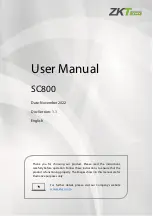
4 | GE Oil & Gas
© 2016 General Electric Company. All rights reserved.
made from carbon and stainless steel (as shown in Fig-
ure 4), the hole (5) (as shown in Figures 6 and 7) is al-
ways threaded ¼"NPT and must be connected to the pipe
conveying the discharge to a suitable place (safely and
constantly at atmospheric pressure).
3.2.4
Bear in mind that the regulated pressure sensing port is
located inside the regulator, therefore the pressure drops in the
inter-connecting piping between the regulator and the point of
use will affect the accuracy of the maintained set pressure. This
pressure drop must be considered when calculating the size of
the connection piping.
3.2.5
When it is essential to avoid pressure variations at the point
of use, the regulators are fitted with an external sensing line con-
nection, as shown in Fig 8. The 1/8" female threaded port must
be connected to a nipple as near as possible to the point of use.
Figure 8
External sensing line (only on request)
3.3 Start-Up and Calibration
3.3.1 The 173 Series pressure regulators are shipped with a
pressure setting at the low end of the adjustable range un-
less otherwise specified by the customer. The pressure setting
can be changed to any value within the adjustable range by
loosening the adjusting screw locknut (14) and turning the
adjusting screw (13) clockwise to increase the pressure setting or
counterclockwise to decrease the pressure setting.
During regulator start-up or operation, do not touch any part of
the regulator as this can conduct heat if the fluid used is at a high
temperature.
3.2 Installation
3.2.1 173 Series regulators must be installed with the actuator
(2) facing upwards and the diaphragm perfectly horizontal, as
shown in Fig.6.
In pressure reducing applications regulating very low down-
stream pressures (normally lower than 100 mm water column),
the regulator must be installed with the actuator facing down-
wards and perfectly horizontal (below pipeline) as indicated by
the nameplate orientation as shown in Fig. 7.
3.2.2 Before installation, ensure that the piping is clean and free
of any debris (machining chips, weld slag, etc). Contaminants
remaining in the piping system can damage internal compo-
nents of the regulator.
When welding piping, do not attach the earth connector to the
regulator as this may damage important sliding parts.
Figure 6
1) Adjustment screw (spring holder)
2) Actuator
3) Pressure gauge
4) Regulator body
5) Drain hole
Figure 7
3.2.3 WARNING/CAUTION ON ATEX USAGE: When handling or
working with harmless fluids (for instance, inert gases, like nitrogen,
carbon dioxide and noble gases) the spring cover is not normally
airtight (ATEX construction, Group II- Cat.2), and has a hole (5) (as
shown in Figure 6) that prevents it from pressurizing if the
diaphragm breaks. If the spring cover is airtight, and
This pipe shall be linked in
case of ATEX construction
Gr. II Cat.2 for flammable
fluids, and must convey to a
suitable place.
Diameter 1/8” scr
ew
ed BSP
Pr
essur
e
sensing


































